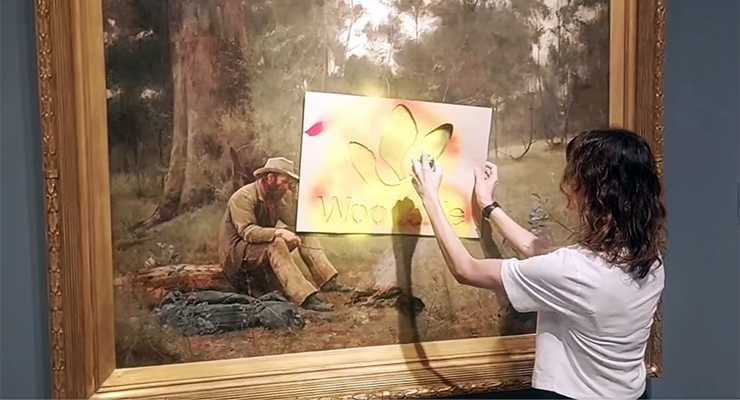
Activists around the world are increasingly taking aim — with oil, soup, syrup and slime — at iconic works of art to protest climate inaction.
Last week Frederick McCubbin’s painting “Down on his luck” joined the growing list of masterpieces subject to a spot of mixed media when it was spray-painted with the logo of oil and gas giant Woodside. The action was designed to draw attention to Woodside’s “ongoing desecration” of sacred Murujuga rock art on the Burrup Peninsula, but ceramic artist and protester Joana Partyka said it wasn’t without collateral damage and criticism.
“When I was deciding to do this, I really oscillated between ‘Let’s get this done, let’s do this’ and ‘There’s absolutely no way I can do this, it’s too risky’,” Partyka told Crikey.
“I tend to be a bit of a ruminator and catastrophiser, so I created a full pros and cons list.”
Partyka was under no illusions about the personal ramifications the action entailed — custody, court, fines, potential employment consequences and public scrutiny. But she decided to proceed.
“Not everyone shares my views and beliefs, and to some my action is akin to going and graffitiing someone’s house or a train or doing something for the sake of destruction itself,” Partyka said.
“But what I think is unfair is that people like me are put in a place of having to take this action to begin with because our decision-makers have failed. I wouldn’t have done this if the government had upheld its end of the bargain.”
She was arrested on-site at the Art Gallery of Western Australia and charged with “criminal damage or destruction of property”. As well as tagging the piece in bright yellow, Partyka glued her hands to the gallery’s walls while Ballardong Noongar man Desmond Blurton rolled out an Aboriginal flag, made an Acknowledgement of Country, and detailed the destruction of historical and cultural First Nations heritage at the hands of Woodside.
Partyka did not dispute the charges but told Crikey she rejected the characterisation of the action as defacing art. The 1889 painting was protected by perspex and came out unscathed.
“The power in the action is in the illusion of damage to the McCubbin painting. This is about protecting art and protecting our planet. Murujuga doesn’t have a protective layer of glass. We have to be the ones who act as that protective layer,” she said.
On top of legal liability, Partyka is also fronting the court of public opinion. Her inbox has been a mix of empathy and abuse with messages to the tune of “You’re a fuckwit”, “You’re an idiot”, “You’re a coward”, and “Your actions have effectively made me not care at all about First Nations issues”.
She called the feedback “fairly tame” and said it indicated the protest had been effective.
Publicly, descendants of McCubbin endorsed the action, as did a collection of climate activist organisations.
In a statement to Crikey, Greenpeace Australia Pacific senior campaigner Richard George said the organisation “does not condone destroying or damaging cultural heritage of any kind”, be that in a gallery or on sacred land, and it expressed relief that the McCubbin piece was unharmed. But it empathised with the motivations of the protesters, saying their action “speaks to the frustration many feel about coal and gas corporations like Woodside being given a free pass to vandalise our most precious resources”.
Australian Religious Response to Climate Change took a similar line, reiterating that although it doesn’t support protest that damages property, the painting was not damaged.
Extinction Rebellion did not respond to a request for comment. Earlier this month Extinction Rebellion UK announced it would move away from disruptive tactics to focus its energy on power politics.
Partyka is currently on surety bail, prohibited from setting foot in certain public spaces — namely galleries and libraries. Although she has not ruled out participating in another action like this, she said she has no plans to do so anytime soon.
“I do worry that the magistrate will come down hard on me as an example and I’ll end up in prison. But if I’m involved in anything like this on bail conditions, it’s a given I’ll be taken into custody and won’t be released,” she said.
Correction: a previous version of this story stated that Extinction Rebellion overall had announced a move away from disruptive protest tactics when the shift had been announced only by Extinction Rebellion UK. The piece has been updated to reflect this.
Are protests such as these effective? Let us know by writing to letters@crikey.com.au. Please include your full name to be considered for publication. We reserve the right to edit for length and clarity.








Crikey is committed to hosting lively discussions. Help us keep the conversation useful, interesting and welcoming. We aim to publish comments quickly in the interest of promoting robust conversation, but we’re a small team and we deploy filters to protect against legal risk. Occasionally your comment may be held up while we review, but we’re working as fast as we can to keep the conversation rolling.
The Crikey comment section is members-only content. Please subscribe to leave a comment.
The Crikey comment section is members-only content. Please login to leave a comment.